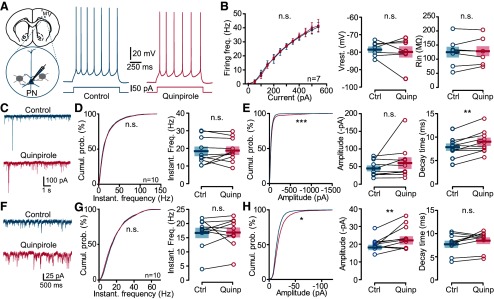Figure 4.
Effect of quinpirole on the electrical activity and sIPSCs (sIPSCs and mIPSCs) of PNs. A, Schematic of the experiment. PNs were identified by their morphology, the absence of tdTomato in their soma as well as their intrinsic properties when possible. Example of voltage responses to +50-pA current injection recorded in a representative PN in control (left, blue) and in quinpirole (right, red). B, Quinpirole did not change the firing frequency of PNs (p = 0.6453, n = 7, F(1,72) = 0.21, two-way ANOVA), nor the resting potential or input resistance (p = 1.000 and p = 0.8982, respectively; n = 7, WSR test). C, Representative traces of sIPSCs recorded from a M1 PN (left) in control conditions (top trace, blue) and in the presence of quinpirole (bottom trace, red). D, Cumulative distribution (left) and mean (right) of sIPSC instantaneous frequency in the control (blue) and in the presence of quinpirole (red). No differences were observed (p = 0.9987, K-S test and p > 0.9999, WSR test). E, Cumulative distribution (left) and mean (middle) of sIPSC amplitude and value of τ (right). Note that cumulative distribution of the amplitude and decay time differed significantly between control and quinpirole conditions (p < 0.0001, K-S, and p = 0.0059, WSR test, n = 10). F–H, Same representations as in C–E for mIPSCs. Note that similarly to sIPSCs, only the cumulative distribution (p < 0.05, K-S test) and mean of mIPSC amplitude differed significantly between control and quinpirole conditions (p = 0.0098; n = 10, WSR test). *p < 0.05, **p < 0.01, ***p < 0.001; n.s., not significant.

